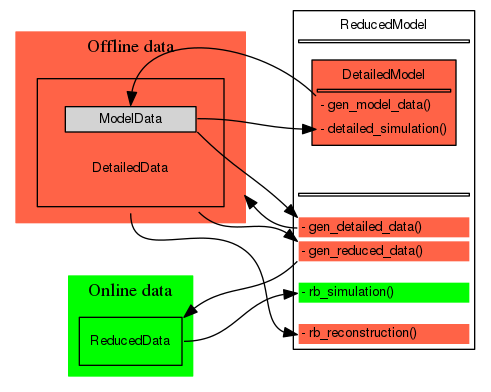|
rbmatlab
1.16.09
|
|
rbmatlab
1.16.09
|
Implementation of reduced models for specific problem types.
This module includes interface classes for the implementation of a complete reduced basis procedure, i.e. offline and online phase and several packages implementing these interfaces for specific problem types.
The interface classes and their interconnections are described in the next section.
A user who wants to implement a reduced basis procedure must implement four classes derived from each of
The graph below depicts, how the classes are interconnected and shows some of the classes' most important methods:


In this section we want to show the steps that need to be undertaken in order to execute a reduced simulation for a convection diffusion equation problem.
The ModelDescr struct for this problem is stored in convdiff_model(). The struct returned by this function also includes fields of the BasisGenDescr struct, so we get the IDetailedModel and the IReducedModel object by the following call of the convenience function gen_models().
We check the types of these models
and find them to be LinEvol.DetailedModel and LinEvol.ReducedModel.
Now, we can compute the ModelData structure and compute a single detailed simulation snapshot:
model_data = gen_model_data(dmodel); set_mu(dmodel, mu); sim_data = detailed_simulation(dmodel, model_data);
The offline phase preparation including the generation of the reduced basis and the computation of the reduced matrices consists of the following two commands:
detailed_data = gen_detailed_data(rmodel, model_data); reduced_data = gen_reduced_data(rmodel, detailed_data);
Again, we can check the types of the generated data objects
disp(['Detailed data is of type: ', class(detailed_data)]); disp(['Reduced data is of type: ', class(reduced_data)]);
and find them to be LinEvol.DetailedData and LinEvol.ReducedData.
Now, it is possible to compute the reduced simulations:
set_mu(rmodel, mu); rb_sim_data = rb_simulation(rmodel, reduced_data);
Further description structs can be found in the models/ directory.

|
Classes | |
| class | BasisGenDescr |
| Struct with control fields for the reduced basis generation. More... | |
Namespaces | |
| NonlinEvol | |
| Reduced basis implementation for non-linear evolution equations. | |
| LinStat | |
| Reduced basis implementation for linear stationary PDEs. | |
| LinEvol | |
| Reduced basis implementation for linear evolution equations. | |
| ARE | |
| Implementation of the parametric algebraic Riccati equation. | |
 1.8.8
1.8.8